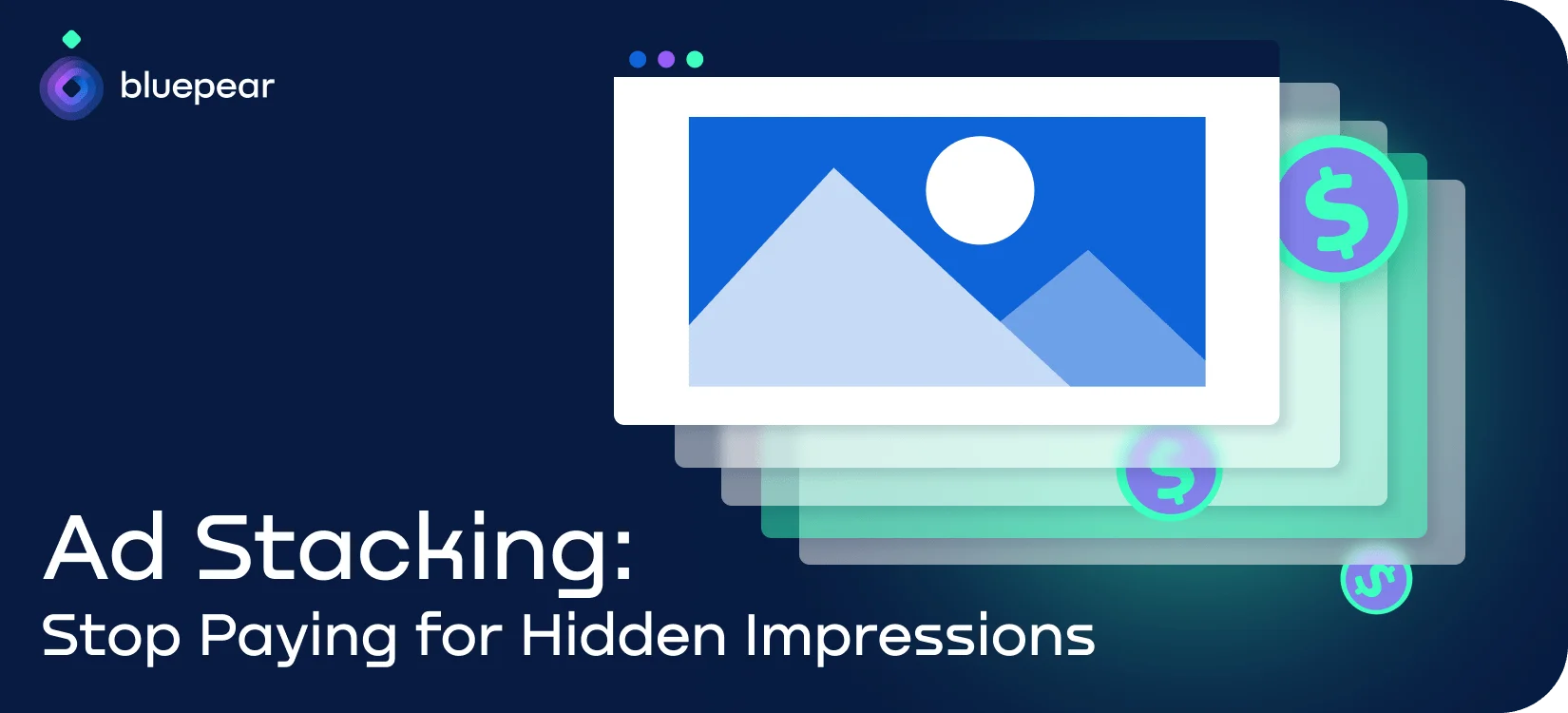
Contents
Imagine: you order a pizza to your office. The delivery guy shows up with a stack of four pizza boxes. Looks impressive — but he hands you only the top one. You open it, eat your lunch, all good.
Then you see the bill — and you’ve been charged for all four pizzas. The three underneath? You never saw them, never touched them, never even knew what was inside. But you still paid for every single one.
Sounds weird but that’s how ad stacking in digital advertising works. What is ad stacking? Here’s a real-life example:
- • The user visits a website and sees one visible ad.
- • But behind that visible ad, the site has quietly stacked multiple hidden ads — layered right on top of each other in the same space.
- • Only the top one is actually seen, clicked, or interacted with.
- • Yet all of them are registered as delivered impressions — and advertisers are charged accordingly.
And unlike a weird pizza delivery, ad stacking is invisible.
Advertisers never know it happened. Until they notice their budget disappearing with nothing to show for it.
Recent statistics show that ad stacking is a real danger for businesses:
- • According to NEXD, 15% of all ad views are fraudulent. Traditional tactics like click spam, ad stacking fraud, and click injection remain significant threats.
- • Emerging markets like Southeast Asia face the highest rates of ad stack, driven by rapid mobile growth and weak fraud controls (Anura.io).
- • Affiliate marketing and programmatic advertising are highly susceptible to fraud, with estimated fraud rates of 45 % (Anura.io).
If you run performance campaigns or manage large ad budgets, chances are you're already paying for impressions no one ever sees. Let’s break down how ad stacking quietly eats into your ROI — and what you can do about it.
What Is Ad Stacking
Ad stacking fraud happens when several ads are loaded into the same placement, but only the top one is visible. The rest stay hidden behind it — yet all are counted as impressions and billed to advertisers. For example, imagine four banner ads loaded into the same 300x250 space. Only the top ad is shown on screen. The rest are hidden behind it. No one clicks them. No one sees them. But advertisers still pay — as if all four were seen.
This trick is hard to detect. Why? Because of the complexity of programmatic ad chains. Ads often pass through multiple SSPs (supply-side platforms) and DSPs (demand-side platforms), each adding layers of tracking, code, and redirection. Fraudsters exploit that lack of transparency. They use JavaScript or hidden iframes to stack ads in one container. On the surface, everything looks normal.
Ad stacking fraud is just one of many affiliate fraud tactics. Others include click injection, fake installs, cookie stuffing, and bot traffic — all designed to artificially boost results and trigger payouts without real user engagement. These schemes often go unnoticed in programmatic and mobile campaigns, where scale and speed leave little room for manual checks.
For brands and affiliate managers, the result is the same: wasted budget, misleading reports, and damage to partner trust.
| Step | What Happens | What’s Hidden from the Advertiser |
|---|---|---|
| 1 | A user opens a webpage with an ad slot | The slot appears standard and safe |
| 2 | The ad tag loads not one, but multiple ads in the same slot | Only the top ad is visible |
| 3 | All ads are technically “served” and counted as impressions | No one sees the hidden ads beneath the top one |
| 4 | Advertisers are charged for each impression | Even though only one ad had any chance of being seen or clicked |
| 5 | Reports show inflated impression counts | Performance looks fine — but ROI quietly suffers |
The Impact of Ad Stacking on Your Budget
Ad stacking fraud may seem like a technical trick — but its impact is real and costly. It doesn’t just drain your budget; it distorts the data you rely on to make smart decisions. Here’s how it affects your campaigns:
Wasted budget. Ad stacking fraud forces you to pay for multiple ad impressions that never had a chance to work. Only the top ad is visible to the user, but all stacked ads are billed as if they were seen. This means a large portion of your media spend is immediately lost — with no possibility of impact, clicks, or conversions.
Bluepear detects affiliates who violate rules in paid search helping you stop paying for invalid traffic driven by search fraud.
Distorted metrics. Hidden impressions pollute your data. Your click-through rate (CTR) drops because only one ad is viewable. Your conversion rate (CR) falls because most impressions were never seen by a real user. By flagging affiliate placements that violate branding rules or use misleading tactics, Bluepear helps clean up your data and improve reporting accuracy. Misleading ROI. When false impressions are counted, your ROI calculations become meaningless. You might scale the wrong campaigns or cut the ones that were actually performing.
Bluepear provides clear evidence (SERP + landing screenshots) so you can isolate non-compliant traffic sources and stop rewarding them.
Brand reputation risk. Stacked ads are often served on questionable websites or low-quality mobile apps. Even if your ad is the one that appears, it may show up in a cluttered, irrelevant, or even unsafe environment. That damages brand perception, reduces user trust, and undermines long-term marketing value.
Bluepear monitors your brand presence in search and identifies suspicious placements to protect how your brand is seen by users.
Affiliate fraud tactics. Ad stacking is often used in affiliate fraud. Fraudsters trigger commission payouts, even though no real engagement occurred. It frequently works alongside click fraud. Together, these tactics create a false picture of success while draining your budget.
Bluepear detects brand bidding, cloaking, URL hijacking, and coupon abuse across paid and organic search.
For any performance-driven team, ignoring ad stacking means risking real money, false data, and lost trust — often without even knowing it.
5 Red Flags of Ad Stacking
Ad stacking is hard to spot, but it leaves behind clues. Here are some of the most common red flags that may signal ad stack in your campaigns:
- • Sudden spikes in CPM or CPC. If your cost per thousand impressions (CPM) or cost per click (CPC) increases sharply without a matching rise in quality or conversions, something is off. You might be paying for impressions that users never actually saw.
- • Unusually high impressions with low CTR. When ad impressions rise but click-through rates drop, it may mean your ads are being “served” — but not actually viewed. This often happens when multiple ads are stacked and only the top one is visible.
- • Slow page load times and high bounce rates. Ad stack can slow down the page. If users leave before the page fully loads, your bounce rate goes up and engagement drops.
- • Discrepancies between ad platforms and analytics. When one platform reports strong delivery and the other shows low engagement or traffic, invisible impressions might be the reason.
- • Low-quality traffic from specific publishers. If one source drives high impressions but no conversions, investigate further. That publisher may use ad stack to inflate performance.
Identifying these patterns early can help you act fast — and tools like Bluepear can help you verify and document violations.
Best Practices to Prevent Ad Stacking
Ad stack can quietly drain your ad budget unless you actively prevent it. Here's what you can do:
- • Work only with trusted SSPs and DSPs. Choose platforms that offer transparent reporting, verified inventory, and strict supply chain standards. Avoid unknown intermediaries or sources with limited visibility into where your ads appear.
- • Include anti-fraud clauses in your contracts. Define what counts as invalid traffic, including non-viewable impressions. Add clauses that allow you to withhold payment or request compensation if fraud is detected. This puts legal pressure on your partners to keep traffic clean.
- • Use advanced affiliate monitoring tools. Affiliates use ad stack to generate fake impressions and trigger payouts. Monitoring tools like Bluepear can help you identify unauthorized ads, policy violations, and cloaked redirects across multiple geos and time slots.
- • Set up automated alerts. Use internal tools or third-party systems to track spikes in impressions, falling CTR, or unusual engagement patterns. Alerts help you respond before small problems become expensive.
- • Combine anti-fraud tools. Bluepear monitors your brand presence in search and detects affiliate fraud like brand bidding and cloaking. It collects solid evidence so you can act fast. Bluepear + ad verification = full coverage.
The key is combining contract-level controls, smart tracking, and reliable tools. Ad stacking fraud thrives in blind spots — your job is to remove them.

Stop Fraud with Bluepear
Ad stacking fraud creates blind spots in your campaigns: skewed metrics, wasted impressions, and invisible threats to your brand’s performance. But with the right tools, these risks are easy to spot and even easier to stop.
By combining affiliate monitoring with ad verification, you get full visibility:
- • who’s placing the ads,
- • where they appear,
- • and whether they’re actually seen.
Bluepear fills the gap most tools miss — uncovering hidden affiliate activity in search, collecting real evidence, and helping you take action quickly and confidently.
FAQ
What is ad stacking fraud?
Ad stacking fraud is when multiple ads are placed in the same slot, one on top of another. Only the top ad is visible, but advertisers are charged for all of them.
How does ad stack affect advertisers?
It wastes ad budget, lowers performance metrics like CTR, and gives a false picture of campaign success.
How can I detect hidden impressions in my campaigns?
Watch for high impressions with low engagement. Use tools that track ad viewability and flag suspicious behavior.
Why is affiliate monitoring essential in 2025?
Because affiliate fraud is smarter than ever and harder to spot without the right tools.

